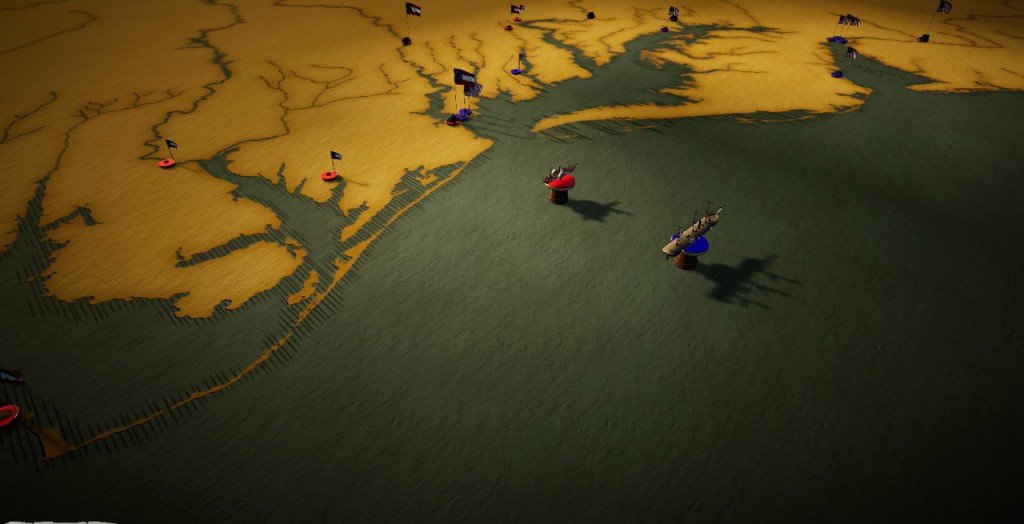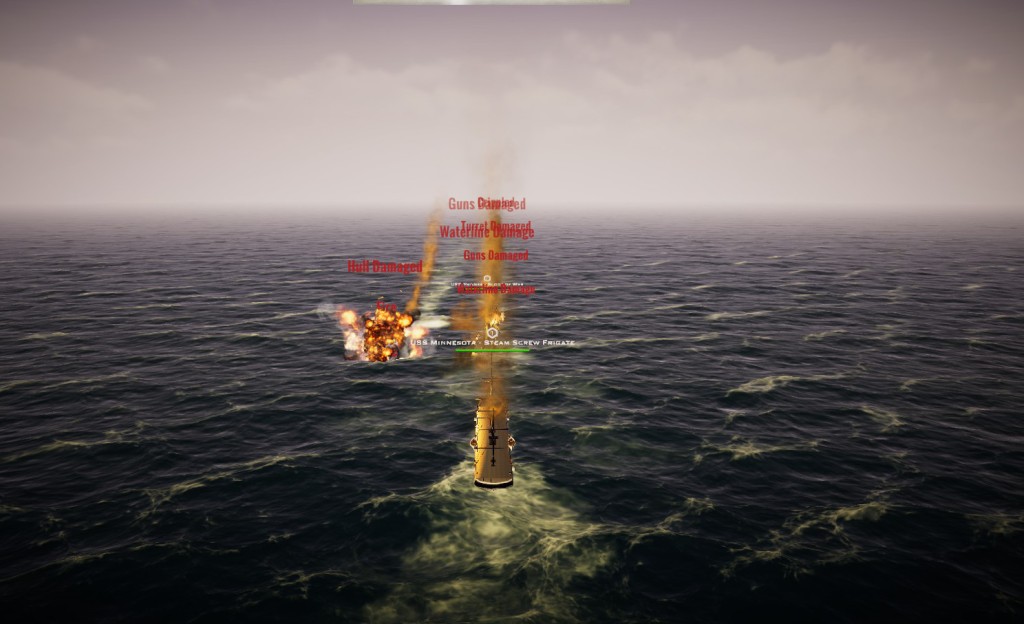Back when I was engaged in the playing of Atlantic Fleet, I added* to my Steam library a demo of a game called Victory At Sea Ironclad. This was a still-in-development title of (if not obvious) American Civil War sea combat which had been out for the better part of the year. Although I wasn’t particularly interested in shifting my game playing to that particular era, Victory At Sea, nonetheless, seemed to fit well within what I was doing. As it turns out, that fit had more to do with my own confusion than anything else – but so does so much else that goes on in my life.
If you read about my experience with Atlantic Fleet, you noticed that I began with a discovery. Steam had been pushing the game War on the Sea, newishly-released in February of 2021. I wasn’t too keen on buying into the brand-new, full-priced release but I did notice that there were two prior titles; Atlantic Fleet and the cold-war themed Cold Waters. Thinking that I just might pick them up at a promotional discount, I realized I already owned them both. Point of confusion #1.
War on the Sea is a title that, like Atlantic Fleet, is set in World War II but moves the action to the Pacific. Again, not a particular era in which I’m interested in at the moment. Somewhere in all of this, though, I got confused with another title. Victory At Sea Pacific has been out since September of 2018 (for reference, not quite as long as Cold Waters) and, perhaps obviously, covers the same ground as War on the Sea. Simply comparing screenshots, the two games look pretty similar. So similar that I got confused (point #2) between the two titles.
As it turns out, the developers of Victory At Sea Pacific are also working on a new title, also released in February of 2021 (can I be forgiven for at least some of my confusion?). In this case, they are moving their focus in both time and place. From the Pacific you go to the Atlantic and also back in time to the American Civil War. Victory At Sea Ironclad, the Steam store entry explains, was intended to improve on the development and release process that may have hurt Victory At Sea Pacific. With the new title, it further explains, the development team is deliberately releasing a beta product so as to shape the development process.
Now, imagine yourself as confused as I was at this point. I’m reading the two Pacific War titles (War on the Sea and Victory At Sea Pacific) as interchangeable; as the same product. I found it a little odd that the demo/Early Access of a new game would come out simultaneously with the full release of the latest completed game, but I didn’t question it. Grabbing the demo of Victory At Sea Ironclad seemed like an easy way to check out what’s new with War on the Sea without the commitment of buying into the new product. Of course, this makes no sense… but I am, as I explained, confused.
Even still, and as I also said, I wasn’t in the mood for Civil War simulation. The game, downloaded, remained unplayed.
As the months ticked by, I figured I probably ought to just give the demo a try, while the whole “beta” thing was still relevant. Said demo consists (unless I am missing something) of a number of tutorial scenarios to give a sense of game play without giving away too much of the game. Should Ironclad strike your fancy, the full game (such as it is) is also out in Early Access for a full purchase price.
Having now gone through the full demo bit, I thought I’d quickly jot down my impressions. I am not going to be buying the Early Access because, still, I’m not that interested in getting into the period and because I’ve finally realized how confused I’ve been all along.
Victory At Sea Ironclad is nothing like Atlantic Fleet. That should have been obvious all along but, for me, it just wasn’t. Now it is. And yet, I remained mired in that misplaced impression as I went on to judge what I was looking at.
Victory At Sea Ironclad is billed as a real-time strategy (RTS) game and it shows. If that’s what you’re after, these features are going to be a positive. If not, then not. It left the confused-me disappointed because Ironclad lacked the casual feeling of the turn-based Atlantic Fleet. But so what? The question isn’t really whether I’d like a turn based Ironclads game better (I bet I would!) but, how fares this version?

Remembering, of course, that I’m reviewing a demo version (even while the alpha/Early Access version is out there), I’ll relate to you what I saw so far. While the tutorial starts you at the tactical level, the game is better appreciated when zooming in from the big picture.
That big picture (pictured above) consists of a strategic level map of the coastal United States. Included on that map (displayed as miniature tokens, flags, and ship models) are the elements of the naval aspect of the American Civil War. The ships represent squadrons or fleets, whereas the flagged donuts represent ports and fortresses. The latter play into the game either as locations for rebuilding and refitting or as targets; one of the tutorial bits has you supporting a seaborne assault upon two Confederate coastal fortresses.
Included in this strategic layer (as very briefly touched-upon in the tutorial) is a theater-wide economic model. Regions under your control can be developed for production of resources and then those resources can be either used or shipped off to Europe (et al) to be traded for higher priority resources. In many ways, this is just a typical element of the RTS genre. At first glance, though, it is a better-than-average implementation of such, taking into consideration the period and the theme.

For the guts of the game, though, you zoom on in to where the salt water meets the hull and direct your ships which you’ve just engaged on the strategic map. Once again, considering that you’re playing a naval RTS, I’d say this is a better-than-most implementation of such. For example, defining squadrons (i.e. grouping units) has a better interface than the typical RTS. Once organized, the squadrons offer formation settings, aligning your orders with certain realities of naval combat. Commands use a “wheel” system, allowing the orders to be more nuanced than simple point-and-click. Down to the individual ship level, the right things seem to be modeled and presented to the user. Ship cannon use the arcs-of-fire and reload times, much as one would expect from a naval combat game. Damage is allocated to subsystems (see above) rather than as simple hit points assigned to each unit. Let’s call Ironclad more Ultimate Admiral than Total War.
I did take away some negatives from my early play (again, demo version!). I found that wheel-of-commands overly confusing. It is easy enough in a tutorial where you’re instructed to select a particular action (and then shown where it is on the interface); I only lost track of what they wanted me to do once or twice. On my own, I was more likely to get confused – for example, commanding my men to hold fire on my main guns when I just wanted to set a target. I was also bothered, at times, by the rapid speed of the game’s execution.
The game is what we pedants would call Pausible Continuous Time, irritated as we are by the “real time” in the RTS designation. The game is played when the clock is ticking and only then. That clock can be sped up to 400X normal (appropriate for waiting out a transit on the strategic map) or slowed down to 0.5X to help observe a more frantic engagement. It can also be paused to peruse the tactical situation at your leisure. That said, the battles feel frantic. To me, an ocean battle should be a slow-moving dance for position punctuated by moments of extreme violence. A truly “real time” sea battle would probably draw out a bit too much**, so I don’t mind a not-really-so-real time clock. In Ironclad, that time compression can feel a bit too compressed.
For example, when I took the tactical screenshot above, I had been trying to figure out the orders screen so as to bring my battle column about and present the enemy with my combined broadside. As I tried, and failed, the enemy ships managed to pull alongside my battle line and, before I could get any of it figured out, the combined weight of my guns had finished them off. Part of it may just be the confusion wrought by an unfamiliar interface upon a newbie player, but I managed to win this battle before I had time to realize it had started.
This also makes me question the AI.
Again, this is a demo consisting of a tutorial (if you hadn’t caught that already), so it is possible that the suicidal AI behavior was scripted in for demonstration purposes. One would hope that an unfettered AI, facing an obviously superior enemy, would try to run rather than stand and fight. Furthermore, once it is a given that the fight is inevitable, one would think an attempt to “cross the T” of an approaching enemy column would be preferred to simply running the gauntlet of the enemy’s guns. Is my success in the tutorial indicative of a bad AI? An unfinished AI? Or just some clever setup for a more cinematic tutorial?
At the end of this whole process, I still have no intention of buying the full priced Victory At Sea Ironclad in the immediate future nor am I motivated to seek out Victory At Sea Pacific. As I said at the outset, the primary driver is that I’m not currently into either of these eras. If I were headed back to the Pacific War, there are plenty of games that I’d want to play before one like this. War in the Pacific would require some dusting off for its grand strategic view as well as Rule the Waves at the tactical level. Were I looking for a “lite” game, I’d be far more likely to plunk down on a turn-based game like War on the Sea before I’d pick up an RTS. If it were Civil War battles I was after, the calculus might be a little different. I have a few “Ironclad” -themed games in my library that I’d try first but the thinner offerings for the American Civil War on the sea might cause me to think seriously about this game.
I will likely check back to see how well it comes through Early Access.
*This is a process that, for demos, seems to involve downloading them.
**With plenty of exceptions to define the boundaries of the discussion. Sub sims, for one example, are good examples of a game where 1:1 real time is the default setting. Even a grand-tactical game like CMANO defaults to real time. Neither of these fit the industry definition of RTS, though. For that tag, rapid movement, engagement, and decision is valued far more than accurate combat simulation.

Pingback: Playing with Fire | et tu, Bluto?